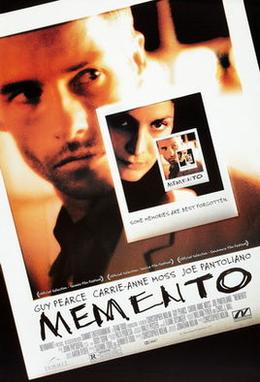The film begins with a blank screen with titles rolling over it. A short narrative opening follows, which is played backwards. I thought this was really effective as it immediately intrigues the audience, especially since the scene that is played backwards portrays the story's ending. This reminded me of the 'Watching: Beginnings' documentary we saw a while ago which told us how a 'favourite trick of film noir, as observed in the 1995 film 'Casino', is to begin a film with the ending' (see my blog post about it here). This in turn also brought to mind a negative review I read of the film that states: 'Nolan uses the structure simply as a gimmick to refresh a stale story of revenge, crime, sex, a film noir that never gets any darker than gris.' (Stanley Kauffmann, New Republic). I thought this was an unfair judgment; maybe the overall premise of the film (man hunts for a criminal he believes killed his wife) isn't very original, but in what other film does that man suffer from short-term memory loss and use notes and tattoos to find the killer? This is what for the most part made the main character of this film so interesting and got us to emphasize with him, even until the surprise end of the film; which brings us to the structure of the film that was also mentioned in Kauffman's review.
The story is told in a non-linear format, with two separate narratives – one in colour and one in black and white – that alternate and finally come together during the final events of the film. The black and white sequences are shown normally enough, but it is the colour scenes that depict the main character Leonard's investigation in reverse chronological order. What is so effective (and so-called 'gimmicky') about this narrative device is that, like Leonard,we do not know of what happened before the current scene, which lets us further emphasize with his condition as we also feel confused. It is this confusion that makes the viewer want to carry on watching, but for different reasons to your typical film, as Nolan gets us to want to know what led up to what we've already seen (primarily the killing of Teddy, but also the photographs Leonard has taken of things we have not seen yet, and aspects of the film such as the broken window of the Jaguar and the pickup truck outside the dilapidated building, all of which only bringing about questions for the viewer), and provides a shock twist that makes us realize that what we saw in the beginning of the film wasn't as significant as the reasons behind it (phew, that was a wordy sentence). This altogether was achieved by giving the audience the clues needed to figure out the narrative, whilst helping us to understand the order of events. For example, the colour sequences shortly overlap with each other to depict that they are not in chronological order. However, with all these clues helping the viewer to get a sense of what's going on (and in turn making them feel absorbed by the narrative and involved), Memento is still the kind of film that requires your full concentration (and, like quite a few thrillers, the kind that you should watch more than once).
 |
| The convergence of the two narratives is depicted with the help of the developing photo |
It would be brilliant to bring in some inspiration from Memento into our thriller opening. I think some backwards-played shots could be really intriguing aspects to include in the opening. Another possible source of inspiration is the fact that Memento revolves around the use of two seperate narratives; however, it would be inappropriate for us to include something like that as we are only creating an opening that should only be about a couple of minutes long. A more plausible idea would be to start the opening with the end of the story – like in Memento (and Casino) – but we've already planned what will happen in our opening and, due to time restrictions, it wouldn't be ideal to start changing our minds.
 Further reading:
Further reading:• http://dinamico2.unibg.it/fa/fa_mem01.html – interesting article by Stefano Ghislotti for 'Film Anthology'.
• http://www.rottentomatoes.com/m/memento/comments.php?reviewid=210692 – extract from that silly review plus some great comments arguing against it.




No comments:
Post a Comment